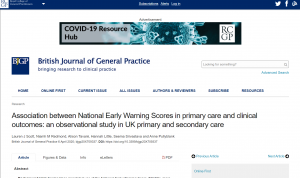Evaluating the National Early Warning Score (NEWS) in out-of-hospital settings
In hospital, early warning scores (EWS) are routinely used to monitor patients’ condition and identify if they are at risk of getting worse. Staff are trained to intervene when abnormal scores are recorded, so that they can give patients the right treatment quickly. These scoring systems are designed to be used alongside a medical professional’s clinical judgement.
Outside hospitals, these scores are not used routinely but they could help to identify and prioritise patients who are most at risk, especially those who might have sepsis. The use of a common scoring system could support communication between healthcare professionals as patients move between care settings, to ensure they see the most appropriate clinician and get the right treatment as quickly as possible.
The National Early Warning Score (NEWS) is a simple scoring system of six clinical measurements which are added together to give an overall score, with various thresholds triggering different clinical responses.
The West of England Academic Health Science Network (AHSN) implemented thresholds and actions as a common approach when NEWS was used in out-of-hospital settings:
- Three or above represented ‘threat’ and required the clinician to think about referral to a hospital or regular monitoring
- Five or above indicated a patient should be ‘referred’ and required urgent medical review in a hospital setting
- Seven or above was considered ‘severe’, leading to an emergency medical review and continuous monitoring
As well as promoting the use of NEWS in hospital, the West of England AHSN is promoting its use in out-of-hospital settings including GP practices, the ambulance service, community care and out-of-hours care, with the aim of using the same scoring system in all organisations across the health system. It is hoped that this will improve outcomes for patients, as those who are most seriously ill should be identified promptly and receive treatment quickly.
Project aims
NIHR ARC West worked with the West of England AHSN to evaluate the effectiveness of using NEWS in these out-of-hospital settings. This project included:
- Reviews of the evidence on the use of early warning scores, including NEWS, both inside and outside hospital, and whether the scores are correctly identifying those patients who need most urgent attention
- Interviews with health professionals who had used NEWS specifically, in a wide range of out-of-hospital settings, addressing the following questions:
- Who is using NEWS in out-of-hospital settings in the West of England AHSN area?
- Why and how are they using it?
- Can NEWS be used effectively in different contexts?
- A study of routinely collected data looking at the distribution and use of NEWS in out-of-hospital settings
- A second study of routinely collected data looking at the association between NEWS recorded when a GP makes an urgent hospital referral and outcomes for the patient
What we did
In the systematic review of existing evidence, the research team looked for studies published up to August 2017 on the use of early warning scores (EWS) in out-of-hospital settings. The review examined how effective the many different early warning score systems are at detecting patients with deteriorating health before they reach hospital, in settings such as ambulance services or nursing and care homes.
Between December 2016 and May 2017, we interviewed 25 healthcare staff from a range of services in the West of England, including primary care, ambulance, community, mental health and hospital referral units about their use of NEWS. The interviews gave staff the opportunity to discuss the benefits and challenges they had encountered while working with NEWS.
We looked at routinely collected data to establish what scores are recorded and how often NEWS is used. Data was collected from 115,030 emergency department attendances, 1,137,734 ambulance service records, 31,063 community health patients and 15,160 GP referrals into hospital. All four datasets included at least one year’s data, starting from April 2016.
Finally, we looked at additional routinely collected data from more than 13,000 GP referrals into hospital between July 2017 and December 2018. We investigated the association between NEWS recorded at the point of referral and outcomes recorded in hospital. The outcomes we were interested in were time from referral to arrival in hospital, time from hospital arrival to review by a doctor, length of hospital stay, intensive care unit admission, infection (sepsis) and death.
What we found and what this means
Results from our systematic review of NEWS in pre-hospital settings
The researchers included 17 studies in the systematic review of pre-hospital EWS. Sixteen were based on measurements taken by ambulance staff and one was in a community nursing home. Six different types of early warning score were examined.
The review found that if patients had very low scores (zero), they were very unlikely to get worse, while those with very high scores (seven or more) were very likely to deteriorate. Scores in the middle were less useful for identifying patients at risk of deteriorating.
No studies looked at whether patient outcomes are different in out-of-hospital settings using an early warning score, compared to those not using one. Further studies are needed to address this question and to evaluate EWS in other out-of-hospital settings.
Results from our interview study
In the interview study, healthcare staff said that NEWS could help them make decisions about the level and priority of care their patients needed. The score could also provide a clear way of communicating concern about a patient to other healthcare professionals, although this was reliant on widespread take up and use across services.
NEWS is designed to be used alongside healthcare professionals’ clinical judgement rather than instead of it. Staff in our study liked the way that the tool could support and check their clinical assessment of a patient, but there were times when they experienced tension between the actions suggested by the NEWS tool and their clinical judgement.
The ability to incorporate NEWS into day-to-day work varied in different services. Ambulance paramedics used NEWS with all patients and it fitted into their routine. GPs had to select which patients to use NEWS with, and sometimes had to adapt patient assessments in order to include NEWS. In community services and mental health, staff reported adapting NEWS to make it relevant to some patients.
The interview study demonstrated that NEWS can work for healthcare staff outside acute hospitals, but in some services it is not straightforward to incorporate into routine clinical practice. A tailored approach to introducing NEWS to different settings may be helpful, and increase staff confidence in the tool. This could include guidance for staff based on evidence from similar services and patient groups to their own.
Results from our first evaluation of routinely collected data
A large proportion of patients had a NEWS between zero and two:
- 80 per cent in the emergency department
- 72 per cent in the community
- 67 per cent of ambulance patients
Only a small number of patients had a score of five or above, which is the trigger for hospital referral:
- 8 per cent in the emergency department
- 12 per cent in the community
- 18 per cent of ambulance patients
Referrals by a GP had higher scores on average, with 46 per cent of scores between zero and two, and 30 per cent of five or above.
Patients with higher scores on admission to the emergency department were more likely to be admitted to hospital, stay for longer, and were more likely to die, than patients with lower scores. For example, 94 per cent of patients with NEWS of seven or more were admitted to hospital or died, compared to 45 per cent of patients with a score of zero.
By April 2016, one year after the start of the roll-out, the use of NEWS was reasonably stable in the emergency department, ambulance and community populations, and still increasing for GP referrals.
These findings suggest that the West of England AHSN’s initiative to increase the use of NEWS has been successful and high scores are reasonably uncommon in most of these out-of-hospital settings.
Results from our second evaluation of routinely collected data
Of the 13,000 GP referrals:
- 42 per cent of patients had a NEWS value of 0 to 2
- 17 per cent had 3 to 4
- 11 per cent had 5 to 6
- 8 per cent had 7+
- 22 per cent didn’t have a score recorded
Higher NEWS values were associated with shorter times from referral to arrival at hospital for patients taken in by ambulance and decreased times from arrival to medical review. Higher NEWS values were also associated with longer hospital stays, more intensive care unit admissions, increased infection rate and a higher death rate.
On average, for patients referred without a NEWS value, most clinical outcomes were comparable with patients with a score of 3 to 4, but the ambulance journey time and time to medical review were comparable with patients with a lower score of 0 to 2.
This study demonstrates that higher NEWS values calculated at GP referral into hospital are associated with a faster medical review. Higher scores are also associated with poorer clinical outcomes, which is to be expected as these patients will be the most ill.
What next?
We are still working on a review of systematic reviews of the early warning scores already in use in hospitals settings.
We will continue to work with the West of England AHSN to share our findings. Since we started the evaluation, NHS England has recommended widespread adoption of NEWS and the Royal College of Physicians has produced an updated version of the tool, NEWS2. The Royal College of GPs are endorsing the use of NEWS in primary care as part of the system-wide response to COVID-19.
Our findings and recommendations for practice will be useful to health care organisations that are implementing NEWS.
Papers

Using the National Early Warning Score (NEWS) outside acute hospital settings: a qualitative study of staff experiences in the West of England
Read the paper
Can early warning scores identify deteriorating patients in pre-hospital settings? A systematic review
Read the paper
Distributions of the National Early Warning Score (NEWS) across a healthcare system following a large-scale roll-out
Read the paper
Association between National Early Warning Scores in primary care and clinical outcomes: an observational study in UK primary and secondary care
Read the paperARC West Staff
Lauren Scott
Senior Research Associate, Quantitative Research/Evidence SynthesisPartners on this project
Health Innovation West of England
Health Innovation West of England is a diverse network of partners working collaboratively to put innovation at the heart of healthcare, to improve patient outcomes and contribute to wealth creation. It aims to do this by translating research into practice, and developing and implementing integrated health care services.
